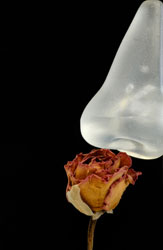Developing a biosensor for odorant screening
Due to their significant advantages, including robustness, portability and low manufacturing costs, biosensors are considered to be promising alternatives to conventional analytical devices. Recent advances in biotechnology and nanotechnology have opened a new way to elaborate biosensors that mimic the olfactory system of mammals with numerous potential applications. In industrial settings electronic noses, comprising an array of electro-chemical sensors capable of recognising simple or more complex odours, could contribute to both process and quality control. Within the European project SPOT-NOSED, the possibility to develop the first nano-biosensor array, based on the electrical properties of single olfactory receptors was explored. A layer of proteins that constitute the olfactory receptors in animal noses was, for this purpose, placed on a nanoelectrode and the reaction when proteins were in contact with different odours was measured. The new biosensor would offer the ability to detect odorants at concentrations that would be imperceptible to humans. Several hundreds of different proteins, which the SPOT-NOSED researchers genetically copied from animals and grew in yeast, were needed for the electronic nose to detect any smell. Different proteins would react to different odorants and it is the resultant combination of reactions that identified a certain smell. Localisation of the olfactory receptor 17 expressed in yeast was performed by means of confocal and electron microscopy, revealing the presence of the receptor at the plasma membrane. Yeast cells were then mechanically disrupted and the plasma membrane fractions were separated from unbroken cells and cell walls by successive centrifugation steps. Inspection by Transmission Electron Microscopy (TEM) of negatively stained membrane fractions indicated that they are composed of circularised nanosomes or unclosed fragments with sizes ranging from 500nm to 40nm. Their size was further homogenised to 40 - 60nm by additional sonication. To obtain a three-dimensional description of the adsorbed nanosomes, membrane fractions were deposited on bare and functionalised gold substrates and imaged with Atomic Force Microscopy (AFM). Although the aspect ration of the nanosomes adsorbed is far from unity, this type of nanosomes incorporating olfactory receptors were found to still contain some aqueous solution inside.







